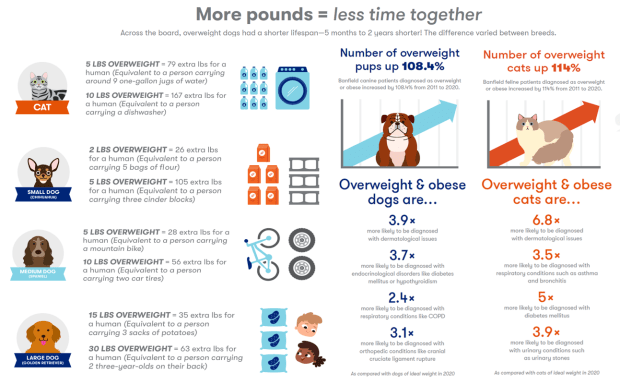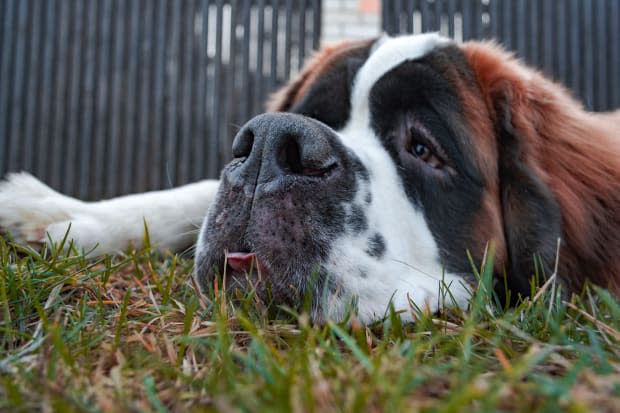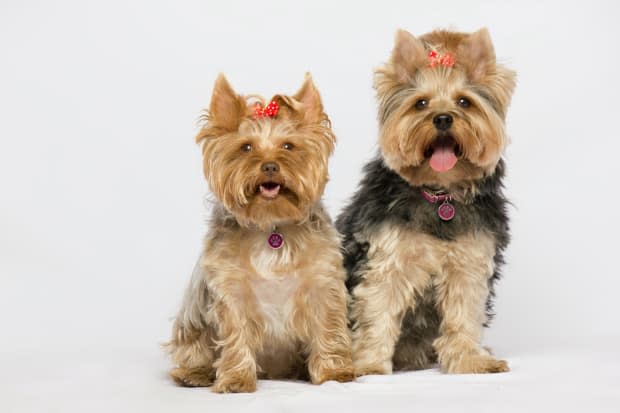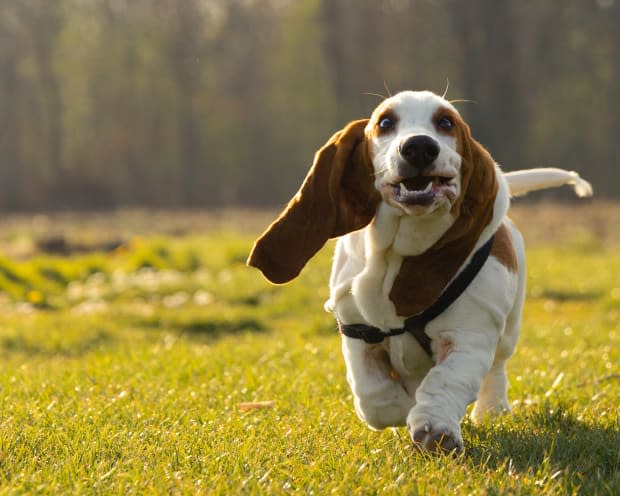Woah, the World's Heaviest Dog Weighed Over 300 Pounds! Plus, 15 Fattest Dog Breeds
Obesity in dogs is a very real problem. While every dog benefits from regular exercise and a regulated, healthy diet, some dog breeds—the fattest dog breeds, really—are just more likely than others to struggle with their weight. In fact, a 2020 survey shows that as many as 56 percent of dogs in the U.S. are either overweight or obese.
Related: Dog Quotes
And their humans don't feel too good about it either. A survey from Banfield Pet Hospital found that 62 percent of pet owners admitted that their pet's obesity diagnosis left them feeling uncomfortable. Of the 1,000 pet owners (whose animals were either overweight or obese) surveyed, 93 percent also said they face hurdles in maintaining a healthy weight for their pets at home.

However common dog obesity is in the U.S., it can definitely be a cause for concern. With obesity being linked to an increased risk of breathing issues, heart disease, diabetes, and even certain types of cancer, it's worth consulting your veterinarian if you think your pup may be putting on some extra pounds. (You can also try out the Association for Pet Obesity Prevention's weight checker tool.)
Related: Fastest Dog Breeds
Keep reading to find out how much the fattest dog in the world weighed—plus, the 15 fattest dog breeds that are prone to obesity.
What is the fattest dog in the world?
An English Mastiff named Zorba still holds the record as per the Guinness Book of World Records. Zorba weighed in at 343 pounds.
Comparatively, the world's tallest dog was a Great Dane named Zeus. He weighed 155 pounds, but when full-grown, was more than 7 feet tall!
15 Fattest Dog Breeds
1. Old English Mastiff
The 343-pound Zorba wasn't the black sheep of his breed by any means. In fact, English Mastiffs are indeed prone to obesity.
This British dog breed typically gets to anywhere from 120 to 170 pounds in females and 160 to 230 pounds in males. Plus, they're known for their lazy dispositions!

Unsplash
2. Saint Bernard
Known as a genial giant for good reason, you may already recognize Saint Bernards as one of the largest (and fattest!) breeds, thanks to a little movie called Beethoven. Males usually range from 140 to 180 pounds while females can weigh anywhere from 120 to 140.
3. Labrador Retriever
It may surprise you to find out that Labrador Retrievers are, in fact, susceptible to obesity. Even though on average, male labs weigh anywhere from 64 to 79 pounds and females 55 to 71 pounds, it's not uncommon for these pooches to really pack it on. This might just be because of their brain's wiring or actually, a genetic disposition.
Research shows that as many as a quarter of labs are born with a gene that doesn't allow their brain to recognize hunger or the feeling of being full.
4. English Springer Spaniel
Bred as hunting dogs, English Springer Spaniels are typically mid-sized dogs. On average, females weigh anywhere from 40 to 50 pounds while males weigh 45 to 55 pounds.
But their bellies can get a little big for their britches if overfed and underexercised. Since English Springer Spaniels are genetically predisposed to health issues like hip dysplasia and joint problems, obesity can exacerbate both.
5. Bulldog
The Bulldog is quite literally known for its roundness, so it should come as no surprise that this breed tends to go overboard. While the Bulldog is quite rotund in nature, if your pup displays shortness of breath or becomes easily tired, it may be a sign that they're overweight. A healthy female bulldog should be between 40 and 51 pounds; a male, between 51 and 55 pounds.
6. Border Terrier
Some terriers seem to be more likely to become overweight or obese and the Border Terrier—a small, British breed bred to hunt—is one of them. Males usually weigh between 13 and 16 pounds while females usually weigh between 11 and 14 pounds, but these rambunctious runners aren't always excited about exercise. To keep them fit, make sure your Border Terrier is getting at least one hour of exercise per day.

Unsplash
7. Yorkshire Terrier
Yorkshire Terriers—or affectionately, Yorkies—are tiny little things. But though they typically weigh only four to seven pounds, they've been known to get a little chunky, too.
According to YorkieInfoCenter.com, this toy breed can often become overweight or obese if the Yorkie in question has a "larger-than-average bone structure." Couple that with too much food or even the wrong food and not enough exercise and, well, your Yorkie could become more squat than a vet would like.
8. Boxer
Originally bred in Germany, the Boxer is a mastiff-type short-haired dog known for its outstanding musculature. Though this breed is often thought of as agile and strong, like the English Mastiff, it can be prone to gaining extra weight.
Studies show that Boxers are predisposed to hypothyroidism, an immune condition in which antibodies attack the dog's own thyroid cells. It can lead to unexplained weight gain, hair loss, behavioral issues, and more.
9. Beagle
Everyone knows just how sensitive a Beagle's nose is and while they make astute hunting dogs, it's not uncommon for this breed to suffer from obesity.
The average male Beagle weighs between 22 and 24 pounds and the average female, between 20 and 22 pounds, but as this breed ages, they become more and more likely to creep into the "overweight" range.
10. Scottish Terrier
Another terrier breed that can skew rather corpulent is the Scottish Terrier. Typically, males weigh between 19 and 22 pounds and females weigh between 18 to 22 pounds. Though they're most distinguishable by their royal disposition and shiny black or gray coats, Scotties can get overweight or even obese.
That's why it's important to give Scotties at least one hour of exercise per day—even if their short legs suggest otherwise!
11. Dachshund
Another notably small breed, Dachshunds—or weiner dogs—may skew a little portly. While this breed should ideally be between 16 to 32 pounds (or under 11 pounds if miniature), the world's heaviest Dachshund, Obie, got up to 77 pounds before embarking on his weight loss journey.
12. Pug
Pugs, too, may be tiny but also, plump. This bug-eyed breed with the curled-over tail should typically be between 14 and 18 pounds, but it's their notorious appetites that often get them into trouble on the scale.
While pugs are certainly not picky with their food, they also commonly suffer from breathing problems, thanks to their brachycephalic bone structure—AKA a flat, pushed-in-looking face. This makes them aesthetically pleasing to many humans who like that kind of look, but it also makes the breed not too enduring of exercise.
All of that combined together and, well, it's kind of the perfect storm for a proclivity for obesity.

Unsplash
13. Basset Hound
Like the Beagle, Basset Hounds are another breed of hunting dog that, too, struggle with their weight. Long, floppy ears and droopy eyelids may be their most distinguishable features, but any Basset Hound owner knows that these dogs love to eat... and overeat, if you'll allow it.
The average Basset Hound female should weigh between 44 and 64 pounds while the average male should weigh between 55 and 75 pounds. But an open-ended love for food and a propensity for begging for treats could very easily tip their scale.
14. Newfoundland
Newfoundlands are typically large in every way with most males weighing between 140 and 180 pounds and most females between 120 and 140 pounds. In most cases of overweight or obese Newfoundlands, overeating is to blame, so it's crucial that owners monitor their dogs' food intake.
15. Rottweiler
The Rottweiler—or Rottie—is another big dog breed. They, too, can reach the weight of a small human with average females getting up to 110 pounds and males up to 130. But like the Boxer, Rottweilers are also prone to hypothyroidism and so to combat this predisposed health issue, it's important to keep them as active as possible.
Next up, the biggest dog breeds.
